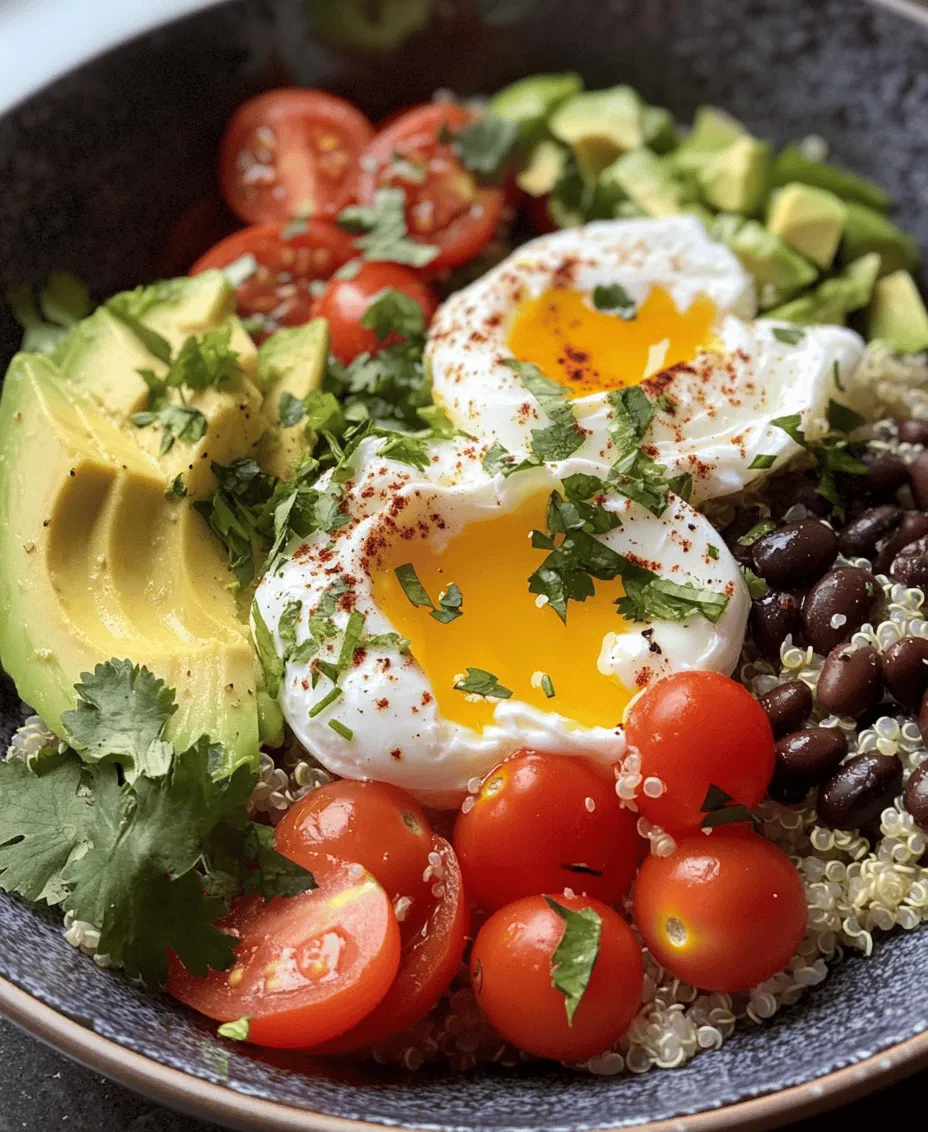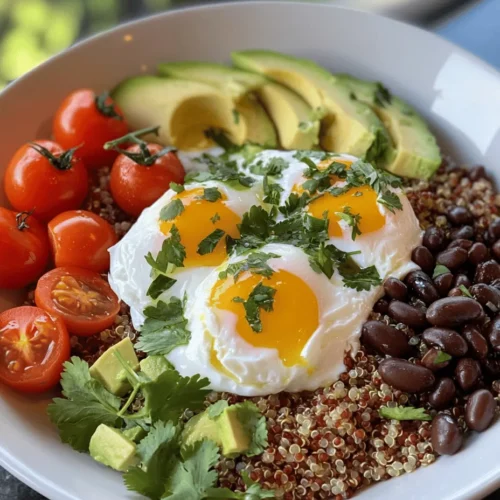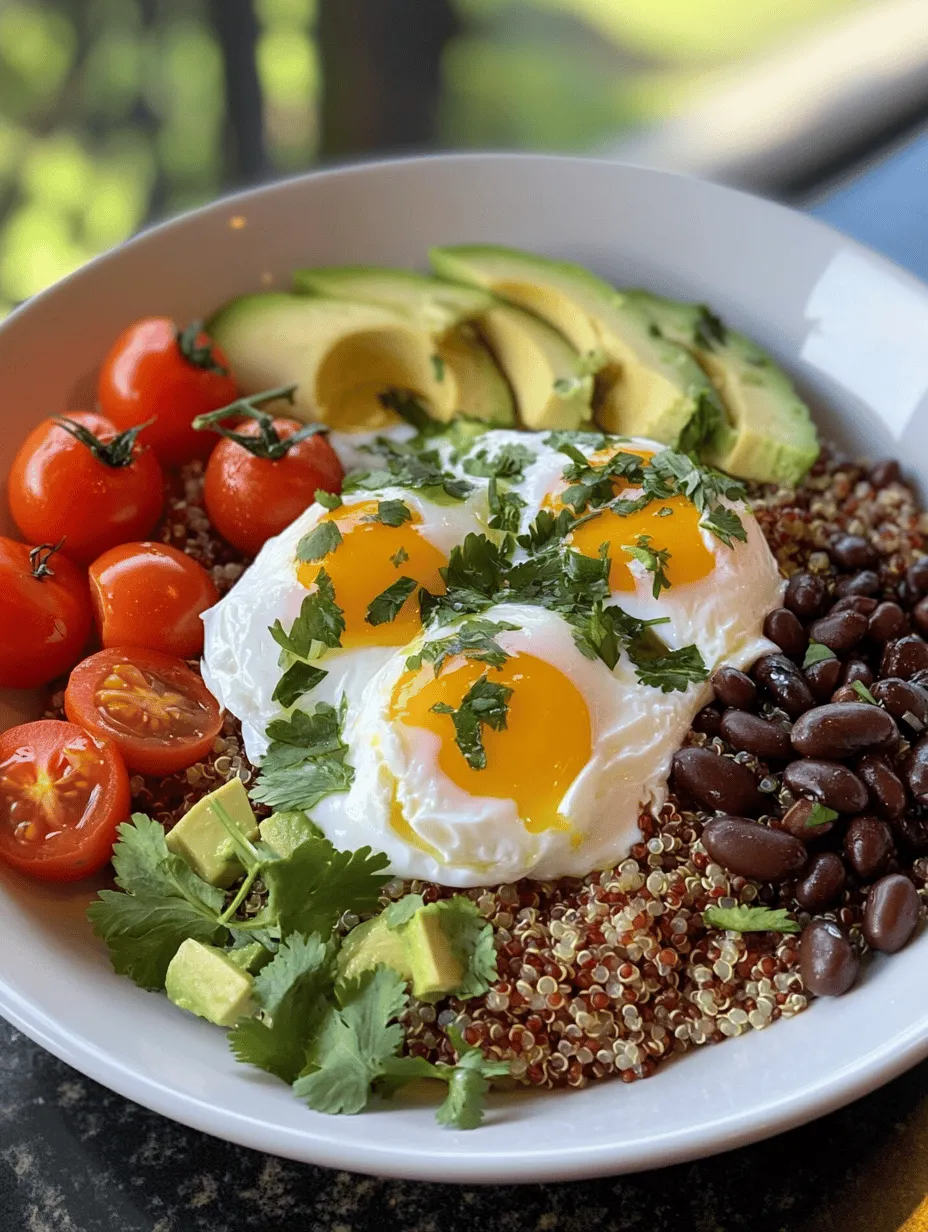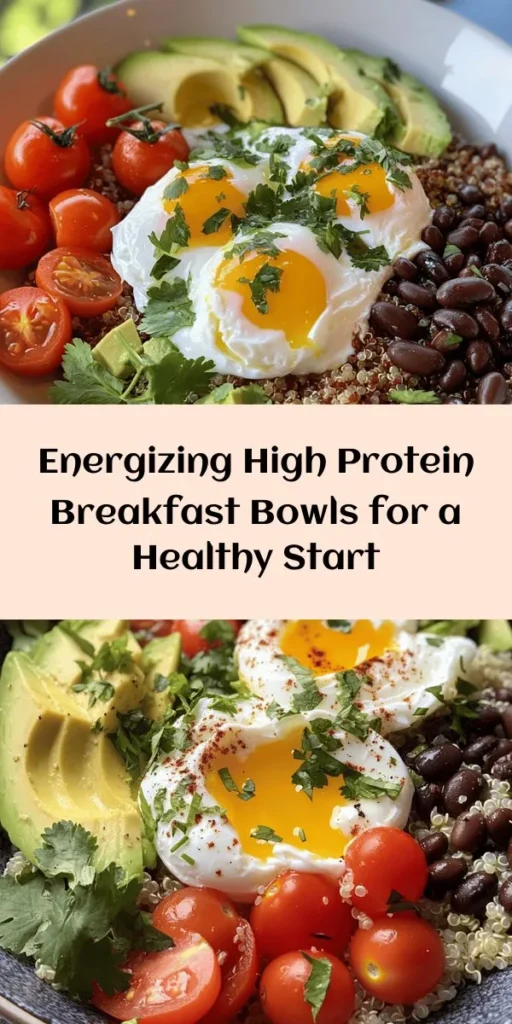Introduction
Starting your day with a nutritious breakfast is crucial for maintaining energy levels, enhancing focus, and promoting overall well-being. A well-balanced meal in the morning can set a positive tone for the rest of the day, helping to fuel your body and mind through busy schedules and demanding tasks. One of the most effective ways to incorporate a plethora of nutrients into your morning routine is through high-protein breakfast bowls.
High-protein breakfast bowls are a delicious and versatile option that can cater to various dietary preferences while providing essential nutrients. They combine a variety of ingredients that not only satisfy your hunger but also deliver sustained energy and health benefits. The Energizing High Protein Breakfast Bowl is a prime example of this concept, packed with a delightful mix of flavors and textures that keep your taste buds excited.
This recipe is not just about filling your stomach; it’s about nourishing your body with wholesome ingredients. The combination of cooked quinoa, Greek yogurt, eggs, avocado, cherry tomatoes, black beans, and fresh herbs creates a harmonious blend that is as nutritious as it is flavorful. This breakfast bowl can help you kick-start your day with a boost of protein, healthy fats, and essential vitamins and minerals.
In this article, we will delve into the significance of high-protein breakfasts, explore the key ingredients that make this breakfast bowl a nutritional powerhouse, and provide you with step-by-step preparation instructions to create your own Energizing High Protein Breakfast Bowl at home.
Understanding the Components of a High-Protein Breakfast
A high-protein breakfast is defined as a morning meal that contains a significant amount of protein to support bodily functions and energy levels. The significance of including protein in your breakfast cannot be overstated. Research has shown that consuming protein in the morning can help regulate appetite, reduce cravings throughout the day, and contribute to muscle maintenance and growth.
Protein aids in energy levels by providing a sustained release of energy, preventing the quick spikes and subsequent crashes associated with high-sugar breakfasts. A breakfast rich in protein also promotes a feeling of fullness, which can help you resist unhealthy snacking before lunch. Furthermore, a balanced breakfast that includes protein can enhance cognitive function, improving your attention span and productivity.
Breakfast is often referred to as the most important meal of the day for good reason. It kickstarts your metabolism, helping you burn calories more efficiently throughout the day. A nutritious breakfast is essential for maintaining stable blood sugar levels, which is vital for overall health. By including a variety of food groups in your breakfast, you can ensure that you are equipping your body with the nutrients it needs to thrive.
Key Ingredients and Their Benefits
The Energizing High Protein Breakfast Bowl is comprised of several key ingredients, each contributing unique nutritional benefits. Let’s take a closer look at these ingredients and their impact on your health:
1. Cooked Quinoa
Quinoa is a whole grain that is often hailed as a superfood due to its impressive nutritional profile. It is a complete protein, meaning it contains all nine essential amino acids necessary for human health. Additionally, quinoa is rich in fiber, which aids in digestion and contributes to a feeling of fullness. This ancient grain is also a good source of minerals such as magnesium, iron, and zinc, making it a fantastic base for your breakfast bowl.
2. Greek Yogurt
Greek yogurt is another powerhouse ingredient in this breakfast bowl. It is an excellent source of protein and probiotics, which support gut health. The high protein content can help repair and build muscle, while the probiotics promote healthy digestion and strengthen the immune system. Greek yogurt also provides calcium, essential for maintaining strong bones and teeth, making it a smart addition to any nutritious breakfast.
3. Eggs
Eggs are often referred to as nature’s multivitamin due to their rich nutrient content. They are a complete protein source, delivering all the essential amino acids your body needs. Eggs are also packed with vitamins such as B12, which is crucial for energy production and brain health, and vitamin D, which supports bone health and immune function. The yolks contain healthy fats and antioxidants like lutein and zeaxanthin, which are beneficial for eye health.
4. Avocado
Avocado is a nutrient-dense fruit that adds creaminess and healthy fats to your breakfast bowl. It is rich in monounsaturated fats, which are heart-healthy and can help lower bad cholesterol levels. Additionally, avocados are high in fiber, potassium, and vitamins C, E, and K, providing a wide array of health benefits. Their creamy texture and mild flavor make them a perfect complement to the other ingredients in the bowl.
5. Cherry Tomatoes
Cherry tomatoes are not only vibrant and visually appealing, but they also provide a burst of flavor and essential nutrients. They are a good source of antioxidants, particularly lycopene, which has been linked to numerous health benefits, including reduced risk of chronic diseases. Cherry tomatoes are also low in calories and high in vitamins A and C, making them a refreshing addition to your breakfast bowl.
6. Black Beans
Black beans are a fantastic source of plant-based protein and fiber, making them a staple in many healthy diets. They are rich in antioxidants and contain essential minerals such as iron, magnesium, and folate. Including black beans in your breakfast bowl not only boosts protein content but also adds a hearty texture and flavor that complements the other ingredients.
7. Fresh Herbs (Cilantro/Parsley)
Fresh herbs such as cilantro or parsley can elevate the flavor profile of your breakfast bowl while offering additional health benefits. They are low in calories and rich in vitamins, antioxidants, and anti-inflammatory compounds. Adding fresh herbs not only enhances the taste but also contributes to the overall nutritional value of the dish.
8. Olive Oil
Olive oil is a healthy fat that provides a host of health benefits, including anti-inflammatory properties and heart health support. It is rich in monounsaturated fats and antioxidants, making it a perfect dressing for your breakfast bowl. A drizzle of high-quality olive oil can elevate the flavors of the ingredients while adding a smooth texture.
Optional Toppings
There are numerous optional toppings you can add to your Energizing High Protein Breakfast Bowl to customize it to your liking. Consider including seeds such as chia or pumpkin seeds for added crunch and nutrients, or sprinkle some crushed nuts for healthy fats. Slices of fresh fruit, such as bananas or berries, can introduce natural sweetness and additional vitamins. Experimenting with various toppings allows you to create a breakfast bowl that suits your taste preferences and nutritional needs.
Step-by-Step Preparation of the Breakfast Bowl
Preparing the Energizing High Protein Breakfast Bowl is a straightforward process that allows you to enjoy a nutritious meal in no time. Follow these detailed steps to create your perfect breakfast bowl:
Step 1: Gather Your Ingredients
Before you start cooking, gather all the necessary ingredients. Ensure you have cooked quinoa, Greek yogurt, eggs, avocado, cherry tomatoes, black beans, fresh herbs, and olive oil. Having everything ready will streamline the cooking process and make it more enjoyable.
Step 2: Cook the Quinoa
If you haven’t already cooked the quinoa, rinse it under cold water to remove any bitterness. Combine one cup of rinsed quinoa with two cups of water in a saucepan and bring it to a boil. Once boiling, reduce the heat to low, cover, and let it simmer for about 15 minutes or until the quinoa is fluffy and the water is absorbed. Remove from heat and let it sit for a few minutes before fluffing it with a fork.
Step 3: Prepare the Eggs
You can prepare the eggs according to your preference—scrambled, poached, or fried. For scrambled eggs, whisk two eggs in a bowl and season with salt and pepper. Heat a non-stick skillet over medium heat, add a small amount of olive oil, and pour in the eggs. Stir gently until they are cooked to your desired consistency. For poached eggs, bring a pot of water to a gentle simmer, create a whirlpool, and gently drop in the cracked egg. Cook for about 3-4 minutes, then remove with a slotted spoon.
Step 4: Assemble the Bowl
Now that your main components are ready, it’s time to assemble your breakfast bowl. Start by placing a generous serving of cooked quinoa at the base of your bowl. Next, add a scoop of Greek yogurt on one side and the black beans on the other. Gently slice the avocado and arrange it on top of the quinoa. Halve the cherry tomatoes and scatter them around the bowl. Finally, place the cooked eggs in the center and sprinkle with fresh herbs for added flavor.
Step 5: Drizzle with Olive Oil
To finish off your Energizing High Protein Breakfast Bowl, drizzle a small amount of high-quality olive oil over the top. This will enhance the flavors and add a lovely richness to the dish.
By following these steps, you will have created a vibrant and nutritious breakfast bowl that is not only delicious but also packed with protein and essential nutrients to fuel your day.
Stay tuned for the next part of this article, where we’ll delve into additional tips for achieving the perfect breakfast bowl and answer some common questions about high-protein breakfasts.

Cooking Quinoa Perfectly: Methods and Tips for Fluffy Results
To achieve a fluffy and delicious quinoa base for your energizing high protein breakfast bowl, mastering the cooking process is essential. Quinoa, often hailed as a superfood, is not only high in protein but also gluten-free and rich in fiber. Here’s how to cook quinoa perfectly:
1. Rinsing: Begin by rinsing your quinoa thoroughly under cold water. This step removes the natural coating called saponin, which can impart a bitter taste if left on the grains.
2. Water-to-Quinoa Ratio: The standard ratio for cooking quinoa is 2 cups of water (or broth for added flavor) for every 1 cup of quinoa. This ensures that the grains absorb enough liquid to become fluffy.
3. Cooking Methods:
– Stovetop: In a saucepan, bring the water or broth to a boil. Add the rinsed quinoa, stir, and bring it back to a boil. Once boiling, reduce the heat to low, cover the pot, and let it simmer for about 15 minutes, or until all the liquid is absorbed. Remove from heat and let it sit, covered, for 5 minutes before fluffing with a fork.
– Rice Cooker: A rice cooker can also be a convenient option. Use the same water-to-quinoa ratio, and let the cooker do its job. It will automatically switch off when the quinoa is cooked, providing perfect results every time.
– Instant Pot: For quick preparation, an Instant Pot can save time. Add 1 cup of quinoa and 1.5 cups of water to the pot. Cook on high pressure for 1 minute, then allow for a natural release for 10 minutes before releasing any remaining pressure.
4. Fluffing: After cooking, always fluff the quinoa with a fork to separate the grains. This will enhance the texture and make it more enjoyable in your breakfast bowl.
Preparing Eggs: Poaching vs. Scrambling – Pros and Cons
Eggs are a key component of the energizing high protein breakfast bowl, providing essential nutrients and enhancing flavor. When it comes to preparation, two popular methods are poaching and scrambling. Each has its own advantages:
Poaching Eggs
– Pros: Poached eggs have a delicate texture and can be visually stunning when served. They are lower in calories since they require no added fat for cooking. Poaching keeps the yolk runny, which can create a delicious sauce when broken over the quinoa and other ingredients.
– Cons: Poaching can be tricky for beginners, as it requires precision in timing and temperature. It’s also less forgiving; if overcooked, the yolk can harden.
How to Poach Eggs:
1. Bring a pot of water to a gentle simmer and add a splash of vinegar (this helps the egg whites coagulate).
2. Crack an egg into a small bowl, then gently slide it into the simmering water.
3. Cook for about 3-4 minutes for a runny yolk or longer for a firmer texture. Remove with a slotted spoon and drain on a paper towel.
Scrambling Eggs
– Pros: Scrambled eggs are quick and easy to prepare, making them a great option for busy mornings. They can be made creamy and flavorful by adding milk or cheese and can easily incorporate herbs and spices.
– Cons: Scrambled eggs can be higher in calories if cooked with oil or butter, and they may not have the same visual appeal as poached eggs.
How to Scramble Eggs:
1. Whisk eggs in a bowl with a pinch of salt and pepper. You can also add a splash of milk for creaminess.
2. Heat a non-stick skillet over medium heat and add a small amount of butter or oil.
3. Pour in the eggs and stir gently with a spatula until just set. Remove from heat before fully cooked to prevent them from becoming rubbery.
Layering the Bowl: Importance of Presentation and Ingredient Harmony
Presentation plays a vital role in making your energizing high protein breakfast bowl appealing. A well-layered bowl not only enhances the visual aspect but also ensures a balance of flavors and textures.
Layering Tips:
1. Base Layer: Start with a generous scoop of fluffy quinoa. Its neutral flavor will serve as a perfect base for other ingredients.
2. Protein Layer: Next, add your choice of eggs—poached or scrambled—on top of the quinoa. This will be the protein powerhouse of your bowl.
3. Vegetable Layer: Incorporate a variety of colorful vegetables, such as diced avocado, cherry tomatoes, sautéed spinach, or bell peppers. Aim for a mix of textures—creamy from the avocado, crunchy from the peppers.
4. Flavor Enhancers: Add spices or sauces for flavor. Consider a sprinkle of feta cheese, nutritional yeast, or a drizzle of tahini dressing to tie the flavors together.
5. Garnish: Finish with fresh herbs like cilantro or parsley for a burst of freshness and a sprinkle of seeds or nuts for added crunch.
Visual Cues for Preparation: Suggestions for Plating and Serving
Presentation isn’t just about aesthetics; it’s also about enhancing the eating experience. Here are some tips for plating and serving your breakfast bowls:
– Use shallow bowls or plates to showcase the layers. This allows for a beautiful display of colors and textures.
– Arrange ingredients in sections rather than mixing them all together. This way, each component is highlighted, making the bowl more visually appealing.
– Consider using contrasting colors; for example, the bright green of avocado against the golden yellow of scrambled eggs creates an eye-catching look.
– Drizzle sauces over the top rather than on the side, which adds a gourmet touch.
Nutritional Analysis of the Breakfast Bowl
Understanding the nutritional value of your energizing high protein breakfast bowl can help you make informed dietary choices. Here’s a breakdown of the nutritional values per serving:
– Calories: Approximately 450-500 calories, depending on the specific ingredients used.
– Protein: Roughly 20-25 grams, primarily from quinoa and eggs, making it an excellent option for muscle recovery and satiety.
– Fats: Around 15-20 grams, largely from healthy sources like avocado and any added oils or nuts.
– Carbohydrates: Approximately 50-55 grams, with quinoa providing complex carbs that sustain energy levels throughout the morning.
– Vitamins & Minerals: This bowl is rich in essential vitamins such as B vitamins (from eggs), vitamin E (from avocado), and minerals like iron and magnesium (from quinoa and vegetables).
Dietary Considerations
This breakfast bowl can easily fit into various dietary needs:
– Vegetarian: Simply omit the eggs or substitute with tofu or chickpeas for protein.
– Gluten-Free: Quinoa is naturally gluten-free, making this bowl safe for those with gluten intolerance.
– Customizable: The recipe can be adjusted to cater to vegan diets by using plant-based protein options.
Versatility of the Recipe
One of the best aspects of the energizing high protein breakfast bowl is its versatility. Here are some suggestions for ingredient substitutions and variations:
Ingredient Substitutions
– Grains: If you’re not a fan of quinoa, consider using farro, barley, or brown rice. Each grain offers unique flavors and textures.
– Proteins: For a vegetarian option, substitute eggs with tofu, tempeh, or a plant-based protein like lentils or chickpeas.
– Vegetables: Feel free to mix and match based on what you have on hand. Roasted sweet potatoes, steamed broccoli, or sautéed mushrooms can all work beautifully.
Seasonal Variations
– Spring: Incorporate fresh asparagus, peas, and herbs like dill or chives.
– Summer: Add grilled zucchini, corn, and fresh tomatoes for a vibrant bowl.
– Fall: Use roasted butternut squash, kale, and spices like cinnamon or nutmeg for warmth.
– Winter: Opt for hearty greens like collard greens or Swiss chard, and consider using winter root vegetables.
Customizing with Toppings
Explore different flavor profiles by adding toppings such as:
– Nuts and seeds (chia, hemp, sunflower) for crunch and healthy fats.
– Sauces (sriracha, tahini, or pesto) to introduce new flavor dimensions.
– Pickled onions or jalapeños for a tangy kick.
The Importance of Meal Prep
Incorporating energizing high protein breakfast bowls into your meal prep routine can significantly streamline your mornings. Here are some benefits and tips for making breakfast easier:
Benefits of Preparing Breakfast Bowls in Advance
– Time-Saving: Preparing ingredients ahead of time can cut down on morning prep time, allowing you to enjoy a nutritious meal even on busy days.
– Healthier Choices: Meal prepping encourages healthy eating habits, reducing the temptation to grab less nutritious options when in a hurry.
– Portion Control: Pre-dividing portions can help you manage your intake, ensuring that you stick to your dietary goals.
Suggestions for Batch Cooking Quinoa and Eggs
1. Batch Cook Quinoa: Prepare a large batch of quinoa at the beginning of the week. Store it in an airtight container in the refrigerator. It can last for up to five days.
2. Pre-Cook Eggs: Consider cooking a batch of hard-boiled eggs for easy access. Alternatively, scramble or poach several eggs and store them in the fridge to reheat quickly in the morning.
Tips for Storing Ingredients
– Refrigerate: Store prepped ingredients in clear containers to easily see what you have available.
– Label: Use labels to note the date when ingredients were cooked or prepared. This helps you keep track of freshness.
– Separate Components: Keep ingredients separate until you’re ready to assemble your bowl to maintain texture and flavor.
Cultural Influences on Breakfast Choices
Breakfast traditions vary significantly around the world, reflecting cultural preferences, available ingredients, and dietary habits. While high-protein breakfast bowls have become increasingly popular, they represent just a fraction of global breakfast choices:
Breakfast Traditions
– American: Breakfast often includes eggs, bacon, and toast, but health-conscious individuals are shifting towards bowls featuring grains and vegetables.
– Japanese: A traditional Japanese breakfast may include rice, grilled fish, and pickled vegetables, emphasizing balance and nutrition.
– Mediterranean: Breakfasts in Mediterranean cultures often feature yogurt, nuts, and fruits, providing a healthy start rich in protein and healthy fats.
– Mexican: Dishes like huevos rancheros showcase eggs alongside beans and tortillas, highlighting the importance of protein and fiber.
Global Breakfast Trend
High-protein breakfast bowls are gaining traction worldwide due to an increasing awareness of health and fitness. They offer a customizable and nutritious option that appeals to various dietary preferences, making them a global trend.
Fusion of Flavors
Incorporating international ingredients into your breakfast bowl can enhance its flavor and nutritional profile. For instance, adding kimchi for a probiotic boost or using tahini for a Middle Eastern flair can create exciting new flavor combinations.
Conclusion
The energizing high protein breakfast bowl is not just a meal; it’s a versatile canvas for creativity and nutrition. By mastering the cooking techniques for quinoa and eggs, understanding the importance of presentation, and exploring ingredient variations, you can create a breakfast that is as satisfying as it is nourishing.
Encouraging experimentation with flavors, this recipe can easily become a weekly staple in your routine. From meal prep benefits to cultural influences, the bowl represents a shift towards healthier breakfast choices that are both delicious and fulfilling. Start your day right with a nourishing meal that fuels your body and mind, setting a positive tone for the hours ahead. Embrace the potential of your breakfast bowl and make it your own!



